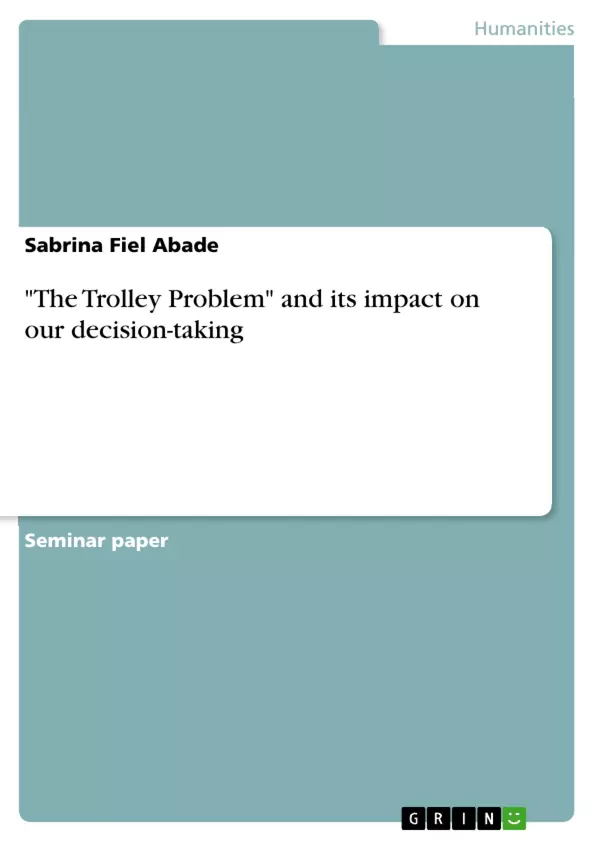“The Trolley Problem” and its impact on our decision-taking, has first been established by Philippa Foot in 1967. In the dilemma she created, we are confronted with two options of action-taking. The death of one person only to save multiple other people, or the death of multiple people because one does not feel in the position to choose to kill the single person.
In order to create a discussion on this topic, I will elaborate how the dilemma is explained by Foot. Since utilitarianism plays a major role in this dilemma, as most people think this is the right way to act, I will briefly explain its idea and how I feel about it. At this point, I want to precise that I will not be going into the definitions of morality, as they would go beyond the scope of this paper. I will only go into the aspects of intending and foreseeing, which are important terms to distinguish in this discussion.
The main interest of this paper lies in applying what we learned about the “Trolley Problem” and the terms that the dilemma implies, in connection with modern technologies. I will do this, by considering some aspects brought by Patrick Lin in “The Ethics of Autonomous Cars”. How would a car act in a trolley case? Can it properly distinguish between intending and foreseeing, and at the same time protect its owner?
Inhaltsverzeichnis (Table of Contents)
- Introduction
- "The Trolley Problem"
- Utilitarianism
- Intending vs. foreseeing
- Applied ethics: Is artificial intelligence capable of good judgement?
- Trolley Problem
- Whose life matters the most?
- Conclusion
- Bibliography
Zielsetzung und Themenschwerpunkte (Objectives and Key Themes)
This paper explores the ethical implications of the "Trolley Problem", a thought experiment that presents a moral dilemma involving choosing between two undesirable outcomes. The paper aims to analyze the problem through the lens of utilitarianism and the distinction between intending and foreseeing harm. Furthermore, it investigates the potential application of these concepts to the development of artificial intelligence and its decision-making capabilities, particularly in the context of autonomous vehicles.
- The "Trolley Problem" and its ethical implications
- Utilitarianism and its limitations in addressing moral dilemmas
- The distinction between intending and foreseeing harm
- The application of ethical principles to artificial intelligence
- The implications of autonomous vehicles in trolley problem scenarios
Zusammenfassung der Kapitel (Chapter Summaries)
- Introduction: Introduces the "Trolley Problem" and its significance as a thought experiment for exploring moral dilemmas. It outlines the key concepts and issues that will be addressed in the paper, including utilitarianism and the distinction between intending and foreseeing harm.
- "The Trolley Problem": Presents the two hypothetical cases proposed by Philippa Foot, highlighting the moral dilemmas they present. It analyzes the arguments for and against switching tracks in the trolley case and discusses the potential for moral conflict in decision-making.
- Utilitarianism: Examines the utilitarian approach to moral decision-making, which suggests choosing the option that maximizes overall happiness or well-being. It argues that utilitarianism may not adequately address complex moral dilemmas, particularly when dealing with individual rights and the intrinsic value of human life.
- Intending vs. foreseeing: Analyzes the distinction between intending harm and foreseeing harm, as it relates to the "Trolley Problem" scenarios. It argues that the distinction is crucial for understanding the moral implications of different actions and for assessing the moral responsibility of individuals and machines.
- Applied ethics: Is artificial intelligence capable of good judgement?: Explores the potential application of the "Trolley Problem" and related ethical concepts to the development of artificial intelligence, particularly in the context of autonomous vehicles. It raises questions about the ability of AI to make moral judgments and the potential for unintended consequences.
Schlüsselwörter (Keywords)
The primary keywords and focus topics of the text include the "Trolley Problem", utilitarianism, intending vs. foreseeing, applied ethics, artificial intelligence, autonomous vehicles, moral dilemmas, decision-making, and ethical implications.
- Quote paper
- Sabrina Fiel Abade (Author), 2021, "The Trolley Problem" and its impact on our decision-taking, Munich, GRIN Verlag, https://www.grin.com/document/1168143



